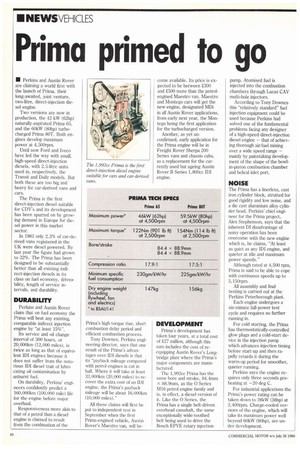Prima primed to go
Page 12

If you've noticed an error in this article please click here to report it so we can fix it.
• Perkins and Austin Rover are claiming a world first with the launch of Prima, their long-awaited, joint venture, two-litre, direct-injection diesel engine.
Two versions are now in production, the 42 kW (62hp) naturally-aspirated Prima 65, and the 60kW (80hp) turbocharged Prima 80T. Both engines develop maximum power at 4,500rpm.
Until now Ford and lveco have led the way with small, high-speed direct-injection diesels, with 2.5-litre units used in, respectively, the Transit and Daily models. But both these are too big and heavy for car-derived vans and cars.
The Prima is the first direct-injection diesel suitable for CDV's and its development has been spurred on by growing demand in Europe for diesel power in this market sector.
In 1982 only 2.3% of car-derived vans registered in the UK were diesel powered. By last year the figure had grown to 32%. The Prima has been designed to be substantially better than all existing indirect-injection diesels in its class on fuel economy, driveability, length of service intervals, and durability.
DURABILITY
Perkins and Austin Rover claim that on fuel economy the Prima will beat any existing, comparable indirect injection engine by "at least 15%".
Its service and oil change interval of 300 hours, or 20,000km (12,000 miles), is twice as long as that of equivalent IDI engines because it does not suffer from the notorious IDI diesel trait of lubricating oil contamination by unburnt fuel.
On durability, Perkins' engineers confidently predict a 160,000km (100,000 mile) life for the engine before major overhaul.
Responsiveness more akin to that of a petrol than a diesel engine is claimed to result from the combination of the Prima's high torque rise, short combustion delay period and efficient combustion process.
Tony Downes, Perkins engineering director, says that one result of the Prima's advantages over IDI diesels is that its "payback mileage compared with petrol engines is cut in half. Where it will take at least 32,000km (20,000 miles) to recover the extra cost of an IDI engine, the Prima's payback mileage will be about 16,000km (10,000 miles)."
All these claims will first be put to independent test in September when the first Prima-engined vehicle, Austin Rover's Maestro van, will be come available. Its price is expected to be between £300 and 2500 more than the petrolengined Maestro van. Maestro and Montego cars will get the new engine, designated MDi in all Austin Rover applications, from early next year, the Montego being the first application for the turbocharged version.
Another, as yet unconfirmed, early application for the Prima engine will be in Freight Rover Sherpa 200 Series vans and chassis cabs, as a replacement for the currently used but ageing Austin Rover B Series 1,800cc IDI engine.
DEVELOPMENT
Prima's development has taken four years, at a total cost of 227 million, although this sum includes the cost of reequipping Austin Rover's Longbridge plant where the Prima's major components are manufactured.
The 1,993cc Prima has the same bore and stroke, 84.4mm x 88.9mm, as the 0 Series M16 petrol engine family and is, in effect, a diesel version of it. Like the 0 Series, the Prima has a single belt-driven overhead camshaft, the same exceptionally wide-toothed belt being used to drive the Bosch EPVE rotary injection pump. Atomised fuel is injected into the combustion chambers through Lucas CAV multi-hole injectors.
According to Tony Downes this "relatively standard" fuel injection equipment could be used because Perkins had solved one of the fundamental problems facing any designer of a high-speed direct-injection diesel engine — that of achieving thorough air/fuel mixing over a wide speed range — mainly by painstaking development of the shape of the bowlin-piston combustion chamber and helical inlet port.
NOISE
The Prima has a linerless, cast iron cylinder block, strutted for good rigidity and low noise, and a die cast aluminium alloy cylinder head. Perkins' chief engineer for the Prima project, Alex Stephenson, says that the inherent DI disadvantage of noisy operation has been overcome with the new engine which is, he claims, "At least as quiet as any IDI engine, and quieter at idle and maximum power speeds."
Although rated at 4,500 rpm, Prima is said to be able to cope with continuous speeds up to 5,15Orpm.
All assembly and final testing is carried out at the Perkins Peterborough plant, Each engine undergoes a six-minute full-power test cycle and requires no further running in.
For cold starting, the Prima has thermostatically-controlled glow plugs and a cold-start device in the injection pump which advances injection timing before start-up and then rapidly retards it during the warm-up period for smoother, quieter running.
Perkins says the engine requires only three seconds preheating at —20 deg C.
For industrial applications the Prima's power rating can be taken down to 28kW (38hp) at 2,400rpm. Charge-cooled versions of the engine, which will take its maximum power well beyond 60kW (80hp), are under development.




















































































































